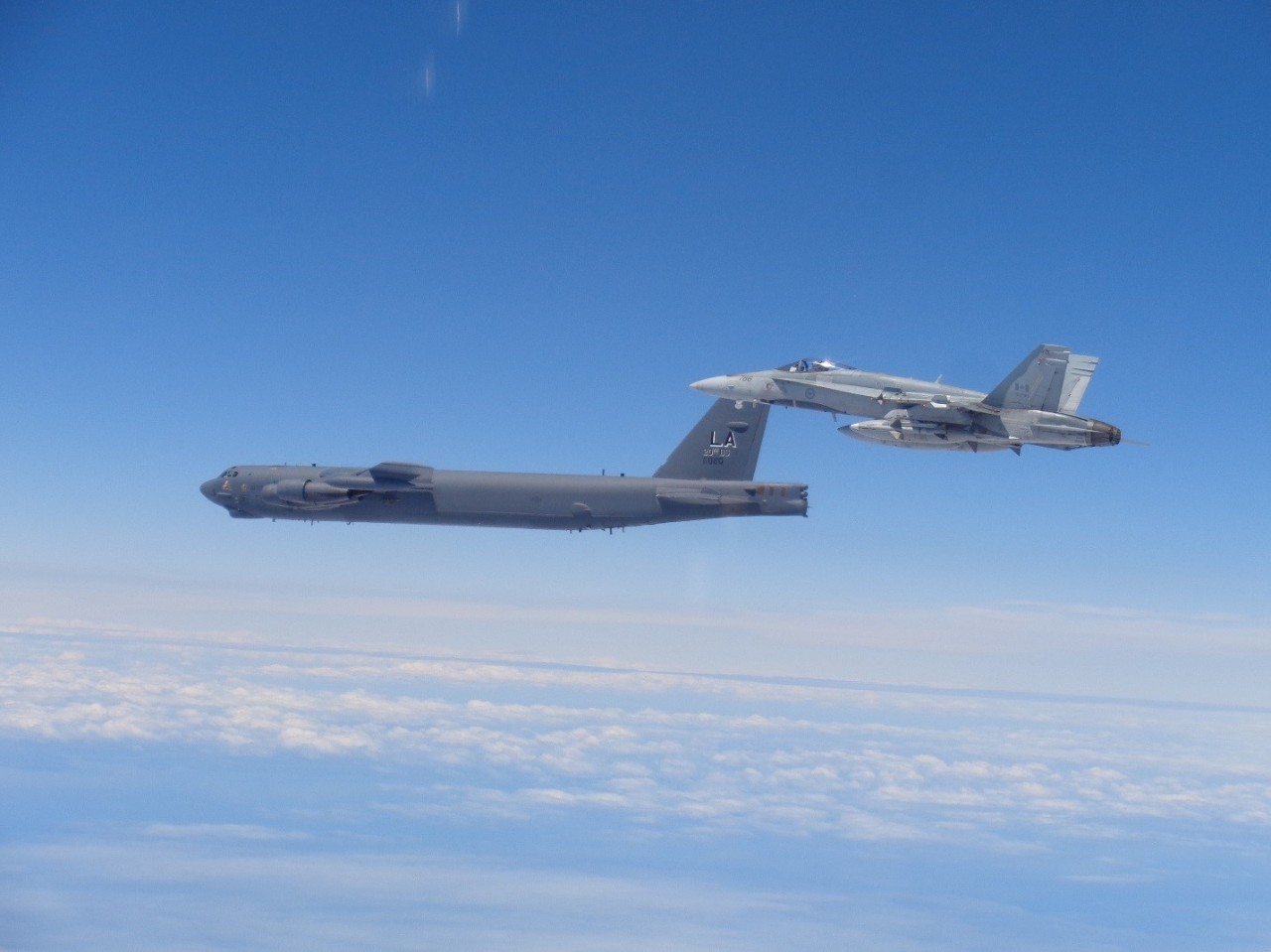North American Aerospace Defense Command (NORAD)

The Royal Canadian Air Force practice identification and intercept procedures with the United States Air Force under the control of The North American Aerospace Defense Command (NORAD) on June 15, 2017.
NORAD: a key CAF partner in North American defence and security
One of the roles of the Canadian Armed Forces (CAF) is to defend Canada and help defend North America. In this role, the CAF joins together with allies and mission partners against perceived common threats. It works mainly with its closest ally, the United States. This is done through several agreements and constructs. This includes the North American Aerospace Defense Command (NORAD).
NORAD is a partner-military entity that was founded in 1958. It was formed by an agreement between Canada and the United States. NORAD monitors North American airspace and maritime approaches. It also defends North American airspace.
NORAD has three missions for North America:
- Aerospace warning: The aerospace warning mission includes detecting aircraft, missiles or space vehicles that might threaten North America. This is done with a global network of sensors. These include satellites and radars on the ground and in the air. NORAD also helps detect and monitor aircraft suspected of illegal drug trafficking. It shares this information with civilian law enforcement agencies. This helps stop the flow of illegal drugs into North America.
- Aerospace control: The control mission ensures the air sovereignty and air defence of the airspace of Canada and the United States. Fighter aircraft from the air forces of both countries are in position to act, if this became necessary.
-
Maritime Warning: The maritime warning mission was added to the NORAD Agreement in 2006. It covers monitoring Canadian and U.S. waters. These include ocean, maritime areas and inland waterways.
NORAD’s main headquarters is located at Peterson Air Force Base, Colorado. It has three regional headquarters:
- The Alaskan NORAD Region (ANR) conducts continuous surveillance and control of Alaskan airspace. It is headquartered at Elmendorf Air Force Base, Alaska;
- The Canadian NORAD Region (CANR) identifies and tracks all aircraft entering Canadian airspace. It also directs all air defence forces in Canada. It is headquartered with 1 Canadian Air Division in Winnipeg, Manitoba; and
- The Continental U.S. NORAD Region (CONR) directs the NORAD air sovereignty mission for the continental United States. It is headquartered at Tyndall Air Force Base, Florida.
The Canadian NORAD Region runs operations and training several times each year. This involves one or multiple NORAD regions. The Canadian Joint Operations Command (CJOC) sometimes works alongside NORAD in this training.
NORAD and the joint defence of North America
The defence of North America is vital to the protection of Canada. NORAD is a major part of the defence relationship between Canada and the United States. The CAF works to be a strong and reliable partner in protecting North America by:
- running recurring operations involving NORAD;
- running training and exercises with the United States;
- responding to crises; and
-
sharing a common operating standard with the U.S. armed forces.
NORAD and the CAF in the North
The defence and security of Canada’s North is key to the defence of North America. The North is a critical region for NORAD.
NORAD maintains the North Warning System. This is a series of 11 long-range and 36 short-range radars. They lie along the entire Arctic coast of North America and are tied in with other NORAD radars. In total, the system forms a radar coverage zone 4800 kilometres long and 320 kilometres wide. It stretches from Alaska across Canada to Greenland. This allows NORAD to detect anything approaching from the air. This includes anything coming from the North.
Canada and United States defence agreements
The NORAD agreement is one of the four main defence agreements between Canada and the United States.
- Permanent Joint Board on Defence (PJBD): Formed in 1940 to advise the Prime Minister of Canada and the President of the United States. It covers defence policy issues about defence and security of North America;
- Military Cooperation Committee: Formed in 1945 to revise the Canada-U.S. Defence Plan for security after World War 2. It now is the main link between the key military staffs of Canada and the U.S.;
- North American Aerospace Defense Command (NORAD): Formed in 1958 to monitor and defend North American airspace. Its mission was expanded in 2006 to include maritime warning; and
-
Tri Command: A working agreement between the Canadian Joint Operations Command, the United States Northern Command, and NORAD. Tri Command is responsible for the defence of North America and making it safe and secure. They have missions that balance each other, in the air and on the ground. They work side by side to meet their individual and common goals. They meet and hold staff talks each year on operations, exercises and plans.
Related links
Western Hemisphere defence partners
Government of Canada
- Canada and the United States
- Canada Border Services Agency
- Canadian Coast Guard
- Canadian Heritage
- Canadian Security Intelligence Service
- Environment and Climate Change Canada
- Fisheries and Oceans Canada
- Indigenous and Northern Affairs Canada
- Parks Canada
- Public Safety Canada
- Royal Canadian Mounted Police
- The Americas (Global Affairs Canada)
Territorial and Indigenous partners
International partnerships
- Royal Danish Navy
- United States Coast Guard
- United States National Ice Centre
- Canada-United States Relations Overview (Embassy of the United States in Canada)